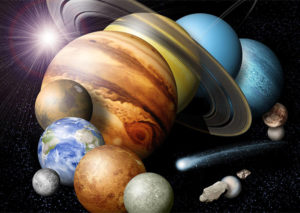
By Beth Barhydt and Albert Huang
Mercury Plays Limbo
Mercury is an evening object in September. However, as the month goes on, Mercury’s position in the sky gets lower in the sky like it’s playing limbo with the horizon. Your best chances of spotting the first planet in our solar system are in the earlier days of the month.
If you can catch Mercury, check three degrees to the upper right for slightly fainter Spica around the 21st and 22nd. Use a telescope to watch Mercury’s waning phase from three-quarters full to one-quarter during the month.
It’s not a very easy- time to-view Mercury—compare it to Venus’ larger elongation—but Venus is also very low in the sky.
Venus Crouches Low in the West
The second planet in the solar system shines bright this month, measuring in at a magnitude of -4.1 on the 9th and 10th, which makes a celestial sight-to-see in pair with a picture perfect crescent moon.
It’s position is relatively low down by the horizon. You can best catch venus around late afternoon and twilight this month. The sister planet’s position will be getting a better position as the month goes on.
Venus’ setting time actually moves half-an-hour earlier in September, even though it moves farther east of the Sun in our sky. Venus doesn’t get enough distance to exceed the rapidly changing time of sunset, since we are at the Equinox. Venus heading toward its aphelion in early October doesn’t help either. Mars and Venus are pretty low down in the sky, which means treelines may hide the peeking planets. Your best bet to catch these two would be at a beach looking to the west.
Mars is Missing
The fourth planet in the solar system is orbiting on the opposite side of the sun, hiding deep into the solar glare to be easily seen. The rusty red planet was in Aphelion in July, meaning it’s at the point in its orbit where it is furthest away from the sun. Mars is now on the path back toward the sun, which will help our solar-energy-dependent probes. Soon enough in the new year, Mars will return to the morning sky, giving us North-Easterners a great view of our red neighbor high in the sky.
Conjunction with the Sun in October makes communication with our Martian probes more difficult. The combination of aphelion and being on the other side of the Sun from us makes Mars look very small, only 3.5 arc-seconds wide, actually slightly smaller than Uranus.
Prime Time for Large Planets
Jupiter and Saturn become conveniently placed evening objects. They are a bit low in the southeastern sky after sunset for those of us with trees filling our southern exposure. Now a month after closest approach, they are easily viewable even with a small telescope.
Spend some time observing the Great Red Spot and Jupiter’s four dancing moons. Saturn’s satellite Titan dances back and forth every 8 days. It isn’t as bright as Jupiter’s big four, but it’s notable in most telescopes. Iapetus, another Saturn moon, brightens up. Although not as much as Titan’s magnitude +9.4, as it moves well out to the west of Saturn, farther out than Titan, getting to its farthest and brightest point at magnitude +10.5 around the 18th.
On the night of the 17th we have a great opportunity to view the moon, Jupiter and Saturn all in a group in the sky. If you’ve got a decent telescope this is also a rare opportunity to watch Calisto, one of Jupiter’s moons, transit across Jupiter and watch its shadow cross the gas giant.
Comet Tale
An old friend of mine, Comet 6P/d’Arrest makes an appearance by the horizon as it does every 6 ½ years. The comet arrives at perihelion, the distance closest to the sun, around September 17th. 6P/d’Arrest will be best visible above the southern horizon as dusk fades to darkness.
I remember picking out this fuzzball with binoculars during several close approaches back in the latter part of the last century. Its diffuse glow and low altitude at sunset will make it very tough viewing this time, even at a maximum brightness, perhaps magnitude +10, later in the year.
 Outer Planets Parade
Outer Planets Parade
Uranus is currently the best placed planet. It sits high up in the sky by the constellation Aries. It’s a bit pale in brightness with the naked eye, but with a telescope you’ll be able to see Uranus’s striking cyan/green hues. Its disc is 3.6 arcseconds in diameter.
Neptune comes to opposition on the 14th up in Aquarius, however the planet is extremely far away and hard to spot. You’ll need a powerful telescope to get a good view of the pretty blue planet. Minor planet Pallas is nearby, about ten degrees over in Pisces at magnitude +8.4.
iPhone/Android Trick
If you have one of those apps that show you a live map of the stars, look for Vega when it first appears after sunset. It’s now almost exactly overhead. Then, flip the phone (or tablet) so it points in the opposite direction, i.e. toward the ground directly below you. Get under the phone and you should see Sirius winking at you. Vega and Sirius are almost directly opposite each other in our sky. I’m still working out when they will next be our pole stars.
When Vega will be the pole star for the northern sky 11,000 years from now, Sirius should simultaneously be the southern pole star, right? What a pair that would be! But the alignment is not exact, so sources don’t list Sirius as the southern pole star until the year 60,000- something. You can view Vega and Sirius in opposition in January during the 6 p.m. local-time hour.
They will be across from each other, Vega low in the northeast and Sirius low in the southwest, but not exactly opposite.
Sighting Earth’s Extraterrestrials
The International Space Station is visible in the predawn sky through the 14th, then in the post-dusk sky for the rest of the month. Vanguard 1 was the second American and fourth worldwide satellite to be launched into orbit. It’s the oldest satellite still orbiting the Earth. It’s only a half-foot wide, so it’s not very visible, ranging from magnitude +10 to +14.
Lunar, Solar and Terrestrial Line-Ups
If you want a general night to go out stargazing and have a clear sky, The new moon falls on the night of the 6th. With the moon passing between Earth and the Sun, there will be very little light pollution in the air, making it a prime time to see a spotted sky.
This new moon also marks the beginning of Rosh Hashanah, or the Jewish New Year. On the other side of the globe, this new lunar month also marks the beginning of Mid-Autumn festival celebrations in China. Look out for mooncakes and celebrations around the official festival dates, the 19th to the 21st.
The equinox is at 3:21 p.m. on September 22nd. This is where the center of the sun’s disk crosses the celestial equator – marking the beginning of Autumn.
The full moon on the 20th is the closest full moon to the night of that equinox, marking it as the harvest moon.
Lunar perigee, when the moon is closest to the Earth, is on the 11th. Lunar apogee, when the moon is farthest from the Earth, will be on the 26th.
Stargazing Apps
To help you through this guide and spot our celestial neighbors a little better, we recommend downloading a stargazing app. My friends and I use SkyView and Night Sky on the App Store. Both are free to use pocket planetariums with option premium services – but are by no means necessary.




